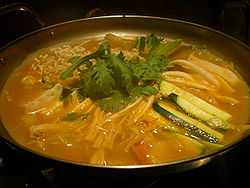Budae jjigae
| Budae jjigae | |
|---|---|
| Jjigae | |
 | |
| Place of origin: | |
| Korea | |
| Recipes at Wikibooks: | |
|
| |
| Media at Wikimedia Commons: | |
|
|
| Budae jjigae | |
| Hangul | 부대찌개 |
|---|---|
| Hanja | 部隊찌개 |
| Revised Romanization | budae jjigae |
| McCune–Reischauer | pudae tchigae |
Budae jjigae (Korean pronunciation: [pudɛ tɕ͈iɡɛ]; lit. "army stew") is a type of jjigae (a thick Korean soup similar to a Western stew). Soon after the Korean War, food was scarce in Seoul, South Korea. Some people made use of surplus foods from US Forces Korea bases around the Uijeongbu area, Pyeongtaek area (also called Songtan)[1] or Munsan area, such as hot dogs, spam, or ham, and incorporated them into a traditional spicy soup flavored with gochujang (red chili paste) and kimchi.
Budae jjigae is still popular in South Korea. The dish often incorporates modern ingredients such as instant noodles and sliced American cheese. Other ingredients may include ground beef, sliced sausages, baked beans, minari, onions, green onions, tteok, tofu, chili peppers, macaroni, garlic, mushrooms and other vegetables in season.[2]
Origin
The dish originated during the Korean War, and was popular for a time afterwards, when people had little to eat. People made this dish by combining leftover Spam and hot dogs from U.S. Army facilities with whatever else was available.[3] All the leftovers were combined with water in a large pot and boiled.[4] The dish is also referred to as Johnson Tang (존슨 탕), combining the surname Johnson for President Lyndon B. Johnson, and tang (탕, 湯) a word meaning soup.[5][6]
The city of Uijeongbu, which is bordered by Seoul to the south and has many army bases, is famous for its budae jjigae. In the late 20th century, the city of Uijeongbu stipulated that the dish be referred to as Uijeongbu jjigae to remove the military or war-time connotation in the name, though not many restaurants follow this guideline. Some restaurants have begun calling their product Uijeongbu budae jjigae. There is also what locals refer to as "Uijeongbu Budaejjigae Street" where there is a high concentration of buddaejjigae restaurants.[7][8]
See also
References
- ↑ "수도권III 우리 동네 명물 송탄의 부대찌개". The Chosun Ilbo (in Korean). 3 December 2009. Retrieved 1 April 2012.
- ↑ Lee, Hyo-won (24 June 2010). "Life post-June 25, 1950: Korean War’s impact on local diet & fashion". Korea Times. Retrieved 1 April 2013.
- ↑ Williamson, Lucy (19 September 2013). "Why is Spam a luxury food in South Korea?". BBC News. Retrieved 19 September 2013.
- ↑ "Korean Food: Stews". Life in Korea. Retrieved 1 April 2012.
- ↑ Lee Yong-sung; Kim Hyun-chul (30 December 2004). "From Trash to Delicious Treasure". The Korea Times. Retrieved 1 April 2012.
- ↑ Kang, Michelle (16 November 2012). "Grandma bone soup is not what you think it is". Joongang Daily. Retrieved 1 April 2013.
- ↑ "Uijeongbu restaurant owners take pride in army base stew". Korea Times. 26 June 2012. Retrieved 1 April 2013.
- ↑ Kim, Violet (6 April 2012). "Food map: Eat your way around Korea". CNN Travel. Retrieved 2012-04-12.
External links
| Wikimedia Commons has media related to Budae jjigae. |
- Guide to the Food Tourism About Uijeongbu Budae Jjigae at the Official Website of the City of Uijeongbu